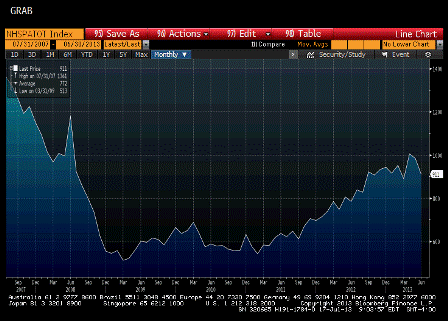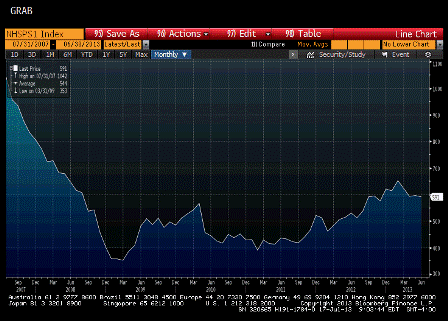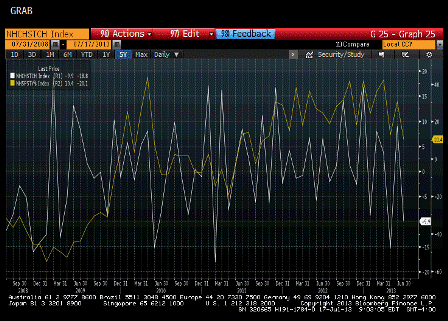PDF: July 18 Presentation
Daily Archives: July 17, 2013 @ 5:26 pm (Wednesday)
Housing Starts in U.S. Unexpectedly Fall to Lowest in a Year
First, this isn’t even being reported on CNBC and is only way down on Bloomberg’s website.
Second, this is the last thing an economy faced with a demand shock from tax hikes and sequesters needs. Housing is the sector of hope for agents’ spending more than their incomes to offset the mounting demand leakages.
Third, the Fed Chairman’s remarks regarding fiscal headwinds having more effect than expected and continuing longer than expected have largely gone unreported as well. He’s right, of course, and in fact the ‘permanent’ deficit reduction is just that, and not only doesn’t go away but makes the fiscal headwinds of the automatic stabilizers that much more of an obstacle.
Fourth, seems ‘confidence’ isn’t all it’s been cracked up to be, as previously discussed…
Housing Starts in U.S. Unexpectedly Fall to Lowest in a Year
Starts of new U.S. homes unexpectedly fell in June to the lowest level in almost a year, indicating a pause in the industry’s progress.
Work began on 836,000 houses at an annualized rate last month, the least since August 2012 and down 9.9 percent from a revised 928,000 pace in May, figures from the Commerce Department showed today in Washington. The reading was weaker than projected by any economist in a Bloomberg survey, and permits for future projects also declined.
The decline was led by a slump in multifamily projects, which can be volatile, and the level of permits remained higher than starts, which may point to a rebound this month. A limited supply of land is also a hurdle for housing, even as near record-low mortgage rates and improving job opportunities draw buyers.
“Housing will continue to grow, but it will be at a gradual pace,” Sean Incremona, a senior economist at 4Cast Inc. in New York and the top forecaster for housing starts in the past two years, according to data compiled by Bloomberg, said before the report.
The median estimate of 83 economists surveyed by Bloomberg was for a 960,000 rate. Forecasts ranged from a 915,000 pace to a 1.03 million rate after an initially reported 914,000 annualized rate in May.
Building permits decreased 7.5 percent to a 911,000 annualized rate in June, compared to a median forecast of 1 million.Single Family
Construction of single-family houses fell 0.8 percent to a 591,000 rate, the fewest since November, from 596,000 the prior month.
Work on multifamily projects such as apartment buildings slumped 26.2 percent to an annualized rate of 245,000, the lest since August 2012.
Private Housing Authorized by Building Permits SAAR

Full size image
US New 1 Unit Privately Owned Housing Units Started SAAR

Full size image
Private Housing Units Started Total MoM and YoY SA

Full size image
Bernanke
Karim writes:
Something for everyone (even uses on the other hand in his remarks); base case remains in place for tapering in September. First mention Ive seen on nature of rate hike cycle: will be gradual. Seems to be looking past the first hike!
Sequencing in these paragraphs is telling. Base case first; risks second(bold). Same pattern appeared in the Minutes. Effective way to stick to your forecast but to try and keep rates in check.
- substantial increases in home prices are bolstering household finances and consumer spending while reducing the number of homeowners with underwater mortgages. Housing activity and prices seem likely to continue to recover, notwithstanding the recent increases in mortgage rates, but it will be important to monitor developments in this sector carefully.
- The price index for personal consumption expenditures rose only 1 percent over the year ending in May. This softness reflects in part some factors that are likely to be transitory. Moreover, measures of longer-term inflation expectations have generally remained stable, which should help move inflation back up toward 2 percent. However, the Committee is certainly aware that very low inflation poses risks to economic performance–for example, by raising the real cost of capital investment–and increases the risk of outright deflation. Consequently, we will monitor this situation closely as well, and we will act as needed to ensure that inflation moves back toward our 2 percent objective over time.
- The pickup in economic growth projected by most Committee participants partly reflects their view that federal fiscal policy will exert somewhat less drag over time, as the effects of the tax increases and the spending sequestration diminish. The Committee also believes that risks to the economy have diminished since the fall, reflecting some easing of financial stresses in Europe, the gains in housing and labor markets that I mentioned earlier, the better budgetary positions of state and local governments, and stronger household and business balance sheets. That said, the risks remain that tight federal fiscal policy will restrain economic growth over the next few quarters by more than we currently expect, or that the debate concerning other fiscal policy issues, such as the status of the debt ceiling, will evolve in a way that could hamper the recovery. More generally, with the recovery still proceeding at only a moderate pace, the economy remains vulnerable to unanticipated shocks, including the possibility that global economic growth may be slower than currently anticipated.
Same for Tapering:
- If the incoming data were to be broadly consistent with these projections, we anticipated that it would be appropriate to begin to moderate the monthly pace of purchases later this year. And if the subsequent data continued to confirm this pattern of ongoing economic improvement and normalizing inflation, we expected to continue to reduce the pace of purchases in measured steps through the first half of next year, ending them around midyear. At that point, if the economy had evolved along the lines we anticipated, the recovery would have gained further momentum, unemployment would be in the vicinity of 7 percent, and inflation would be moving toward our 2 percent objective. Such outcomes would be fully consistent with the goals of the asset purchase program that we established in September.
- I emphasize that, because our asset purchases depend on economic and financial developments, they are by no means on a preset course. On the one hand, if economic conditions were to improve faster than expected, and inflation appeared to be rising decisively back toward our objective, the pace of asset purchases could be reduced somewhat more quickly. On the other hand, if the outlook for employment were to become relatively less favorable, if inflation did not appear to be moving back toward 2 percent, or if financial conditions–which have tightened recently–were judged to be insufficiently accommodative to allow us to attain our mandated objectives, the current pace of purchases could be maintained for longer. Indeed, if needed, the Committee would be prepared to employ all of its tools, including an increase the pace of purchases for a time, to promote a return to maximum employment in a context of price stability.
- if a substantial part of the reductions in measured unemployment were judged to reflect cyclical declines in labor force participation rather than gains in employment, the Committee would be unlikely to view a decline in unemployment to 6-1/2 percent as a sufficient reason to raise its target for the federal funds rate. Likewise, the Committee would be unlikely to raise the funds rate if inflation remained persistently below our longer-run objective. Moreover, so long as the economy remains short of maximum employment, inflation remains near our longer-run objective, and inflation expectations remain well anchored, increases in the target for the federal funds rate, once they begin, are likely to be gradual.
6.5% threshold and first mention (that Ive seen) on the pace of rate hikes
Bank earnings as a demand leakage
All unspent income is called a ‘demand leakage’ as it means the output can’t get sold unless another agent spends more than his income. (by identity, not ‘theory’) And unsold output leads to cuts in output, cuts in employment, etc. etc. and down you go until some agent spends enough more than his income to offset the demand leakages. Invariably that agent is govt, as the automatic fiscal stabilizers increase the deficit. Of course they also work in reverse, providing an increasing headwind to the economy as it grows, via higher revenues and lower transfer payments. Like what’s happening now, which has brought the deficit down dramatically over the last few of years..
Anyway, when a bank has income and pays it out as shareholder income, that’s not a demand leakage. And if the shareholders don’t spend their income, that is a demand leakage. etc.
But if a bank earns income and doesn’t pay it out or spend it, but instead lets its equity capital increase, that is a demand leakage.
So what’s happening in general is top line growth is pretty much flat, with earnings not being spent, but instead adding to net worth and therefore the earnings are demand leakages. This includes the housing agencies/banks who are now turning over their incomes to govt.
Remember this from the Fed?
The Automatic Stabilizers: Quietly Doing their Thing
By Darrel S. Cohen and Glenn R. Follette
Abstract: This paper presents theoretical and empirical analysis of automatic fiscal stabilizers, such as the income tax and unemployment insurance benefits. Using the modern theory of consumption behavior, we identify several channels–insurance effects, wealth effects and liquidity constraints- -through which the optimal reaction of household consumption plans to aggregate income shocks is tempered by the automatic fiscal stabilizers. In addition we identify a cash flow channel for investment. The empirical importance of automatic stabilizers is addressed in several ways. We estimate elasticities of the various federal taxes with respect to their tax bases and responses of certain components of federal spending to changes in the unemployment rate. Such estimates are useful for analysts who forecast federal revenues and spending; the estimates also allow high- employment or cyclically-adjusted federal tax receipts and expenditures to be estimated. Using frequency domain techniques, we confirm that the relationships found in the time domain are strong at the business cycle frequencies. Using the FRB/US macro-econometric model of the United States economy, the automatic fiscal stabilizers are found to play a modest role at damping the short-run effect of aggregate demand shocks on real GDP, reducing the “multiplier” by about 10 percent. Very little stabilization is provided in the case of an aggregate supply shock.
